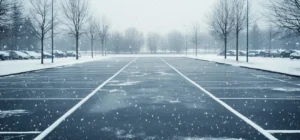OUTCO are the winter gritting and snow clearing experts and we’re here to keep your sites safe and compliant. This article answers your top five most popular winter gritting and snow clearing questions.
Question 1: When should I book my winter services?
This is the most popular question we get asked and our advice is simple: don’t wait until it gets cold to arrange your winter gritting and snow clearing services. Contact us today to book your winter gritting services or arrange a free site inspection.
Question 2: How do you know when to grit?
In simple terms, the trigger temperature for us to carry out gritting is 0 degrees (the freezing point of water). We employ accurate and sophisticated technology that measures local Road Surface Temperature (RST) rather than relying on air temperature forecasts. The temperature of our roads often stays higher than the air around them due to them retaining heat from the sun longer than the surrounding air. Roads also don’t cool down as quickly as objects such as cars, which is why your car may be covered in frost, while the roads are clear.
We’re proud of our industry-leading temperature and weather forecasting accuracy of 97.8% at any specific location.
Question 3: What de-icing products do you use to grit the road and pavements?
OUTCO primarily uses white marine salt as our main de-icing agent, due to white salt being highly effective, clean to use and more environmentally friendly than mined rock salt (brown salt). As white salt is more effective for de-icing than brown salt, less volume is required for the same de-icing result.
[pullquote]Our aim is always to ensure optimal coverage is achieved. It’s not just a case of ‘more is better’ as adding more salt will not speed up the time it takes the ice to melt.[/pullquote]
White salt is less harmful to plants and vegetation than other forms of gritting products and it’s much cleaner too, leaving less residue on sites and stains on carpets when trodden into buildings.
OUTCO is at the forefront of de-icing snow clearing technology and we are continuously testing and evaluating bespoke de-icing treatments and new products. We understand and appreciate how specific locations may need to be managed differently. For example, we have extensive knowledge of the de-icing of rail platforms and over bridges where large volumes of exposed metal and ironwork are present. These surfaces do not react well to corrosion, and by using a low corrosive solution we have improved asset longevity while keeping them safe and compliant.
Question 4: Can you grit when it snows?
Salt is effective on snow that is less than 40mm deep. Any more than this and the snowmelt will dilute the salt too much that it will become ineffective. In most circumstances, we recommend that snow clearance takes place once the snow has fallen, followed by winter gritting to prevent ice from forming.
Question 5: When is the best time to grit?
This depends on many factors and there isn’t a single answer we can provide to cover all situations. Typically, we experience freezing conditions at night and early in the mornings, which will cause ice to form. Winter gritting at this time is usually best, as it gives the salt time to work before people need to use the roads and walkways. It is not uncommon for us to visit exposed locations numerous times during a 24hr period, especially if the temperature stays below freezing or weather conditions change. Our team constantly monitors weather conditions and we can provide a service that meets your exact needs.
To find out how we can work together, or to obtain a free winter gritting quote or site inspection, please contact us today.








